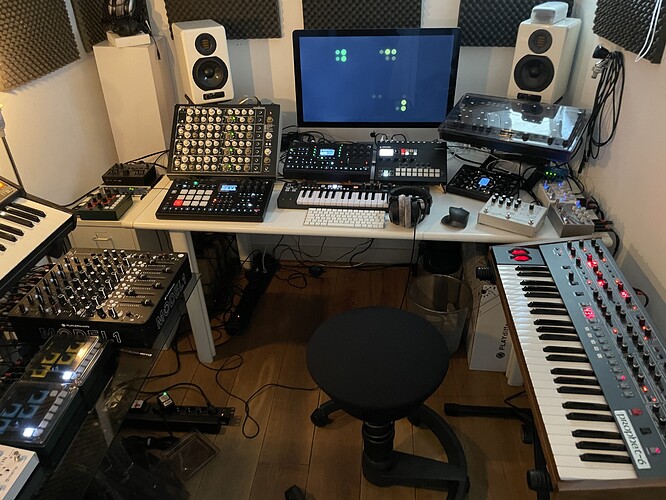I was going to reply to this, but feel now like I’m intruding on some seriously deep stuff but anyway.
I use Pyramid for sequencing. I record, edit and add some effects (although getting more into external effects now, for example, the UAD Astra pedal is simply spectacular) in Reaper.
I’ve been using Reaper for a literal million years (2953 days according to its little counter) and I’ve always loved it, but found it difficult to come up with ideas and maintain that idea long enough to get into into some kind of serviceable form before forgetting what I was doing. I had been searching for a sequencer for a very long time, but could never find anything that did what I wanted in the way I wanted, until I came across the Pyramid from that Sunshine Jones video he put out years ago. Pretty much sold straight away, and ended up getting unit 880 (so close…) and I’ve never looked back.
I basically have a big keyboard controller going into the input of the Pyramid (and also an Expressive É Touché, but it generates far too many CC events to record with - more on that later) and then all my synths on MIDI splitters from the two outputs. Outputs A + B both send clock, but only A sends Start and Stop messages, so anything that I want to run when Pyramid runs goes off that, and anything that I either don’t care, or specifically do not want (internal POS sequencer of the Toraiz AS-1: I am looking at you) goes off B. USB to the PC, with Reaper being the master clock when recording.
When running through ideas, I basically have everything through from my master keyboard, selecting the MIDI channel on the Pyramid (due to my controller keyboard not allowing you to easily change MIDI output channels - something I miss from my old M-Audio one) and just play around with ideas. When I come up with something good, I record it, loop it, and have it playing within minutes. Rinse and repeat. I can basically build up a whole track in abut half an hour doing this, or at least enough to start really working on it. For creating scratch ideas, I’ve never found anything better.
Drums are done with an Elektron Analog Rytm, once I got my head around it, it’s the best sequencer for drums, I like that you can jump between sequences before you get to the end of a bar (Volca Beats does this also) so you can create all sorts of fills and stuff without it being too ‘regimented’ and as that has Dinsync, I have a 303 off of that.
I tend to only record notes into the Pyramid, although occasionally do CC automation if it’s something specific as part of the loop, and then when recording audio into Reaper, I’ll ride the controls of whatever synth, usually on instinct without any real plan. I also use the Touché this way (as said above, it generates far too many CC values - the Pyramid fills up very quickly and becomes pretty slugging saving and loading.
These days I tend to just have a project open and fill it with whatever until it’s got stuff all over the four pages of Tracks, then start a new one.
I’ve taken the Pyramid out on one set of shows, using it as the master clock, with the Rytm (+303) on one output, then the AS-1 and a Kawai K1m on the other. I used the Program Change effect page (rather than the fx) for each track I was playing, with the AS-1 all along the top line, and K1m all along the bottom, in the order and roughly paired for the whole show (was about 38 tracks in total) and then had an old MIDI controller to control the AS-1, because although it sounds amazing, there are not nearly enough knobs on it for my liking). I generally am a little drunk (or more) by the time I’m playing, so it was good to know all I had to do was press the next button along and then hear what was playing and go “oh yeah, this bit” and then I knew what to do. So basically for that, the Pyramid and especially the Program Change stuff was an absolute godsend. It was a neat setup, and I really enjoyed it (apart from the one time I left the SD card at home after backing it up before going out) but I am lazy, so since reduced my setup to just the Rytm, the 303 and an MC-101 (which has an OK(?) sequencer - not sure if I’m totally spoiled by the Pyramid) which can fit in 2 small bags rather than one massive suitcase)
I am intrigued by the talk people have had hear for using the Novation Launchpad to trigger track mutes with Pyramidi, and if the smallest one had proper MIDI or the Pyramid served as a MIDI host (which I would maybe assume any future hardware version of it might) then I’d have really looked into that more, but it’s a nice to have, it’s not really an issue.
![]()
![]()








